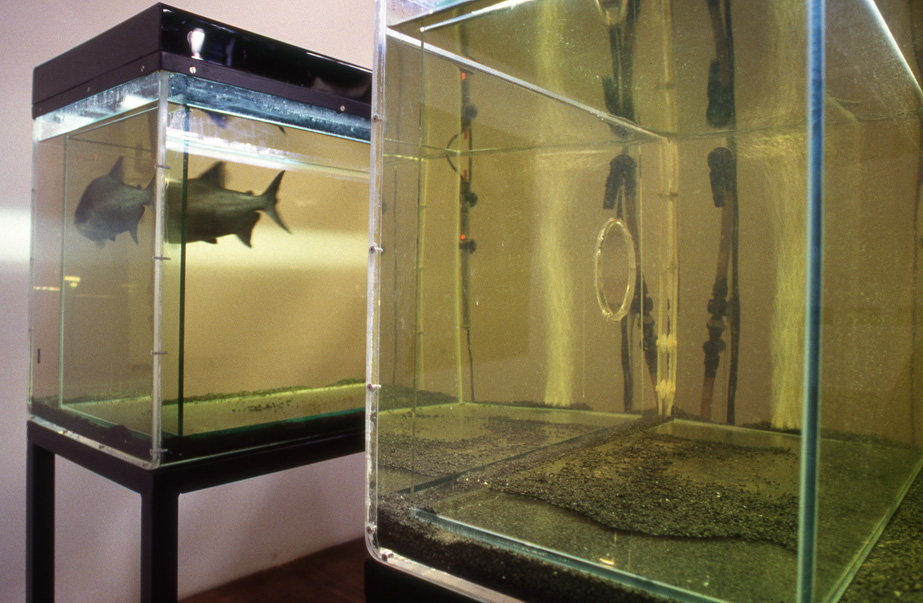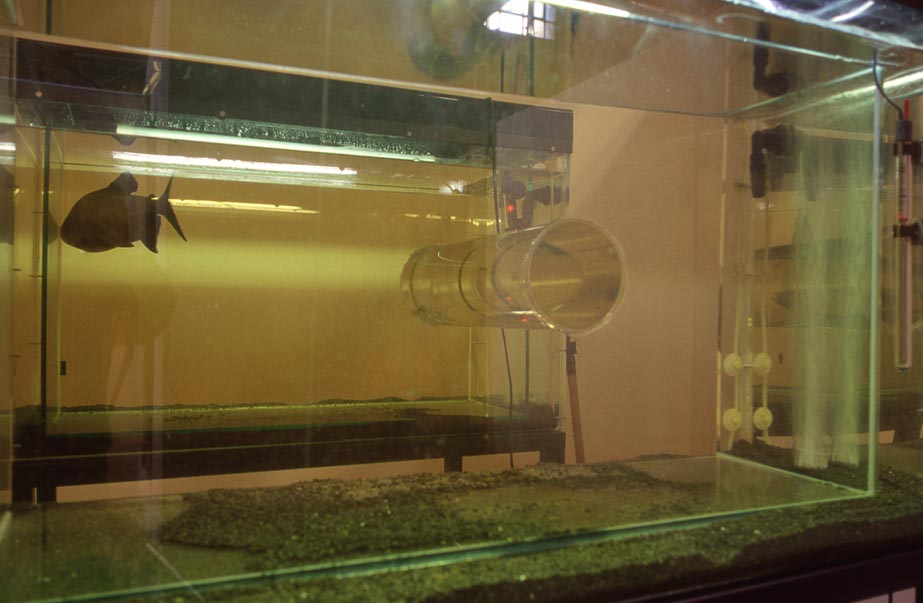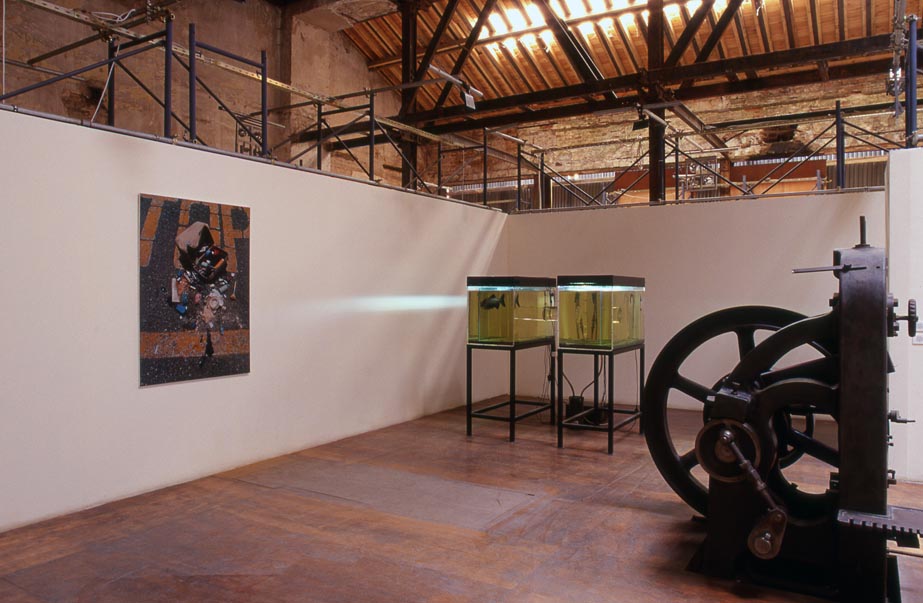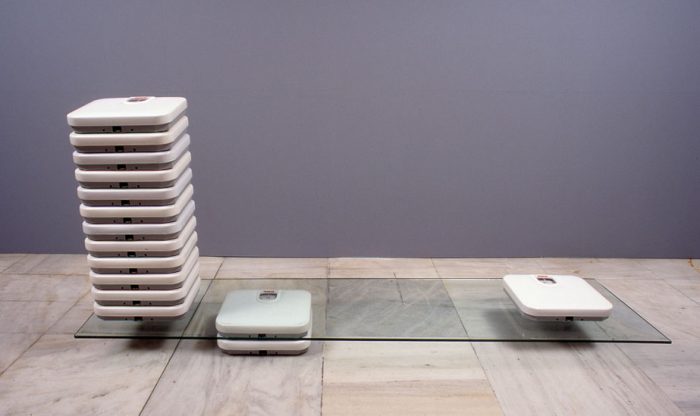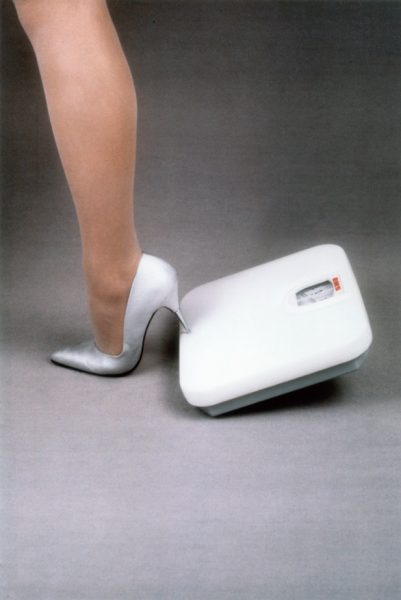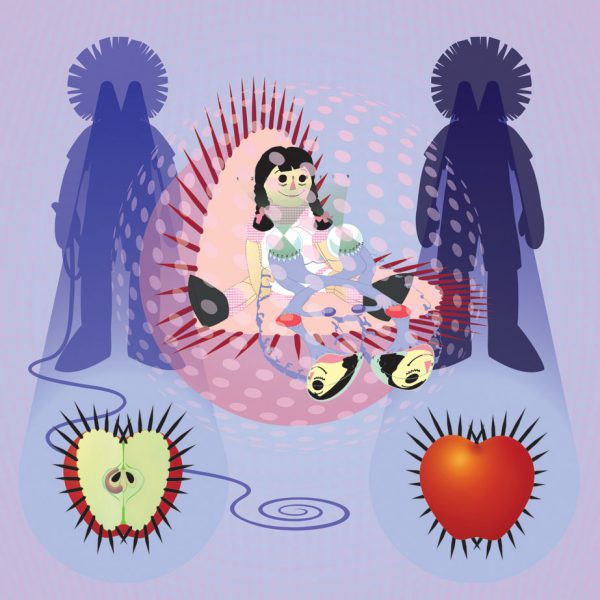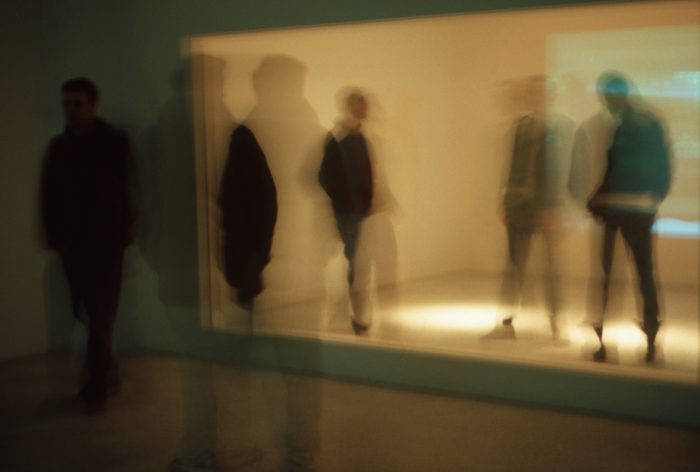A functioning aquarium. Sophia Kosmaoglou, 1996
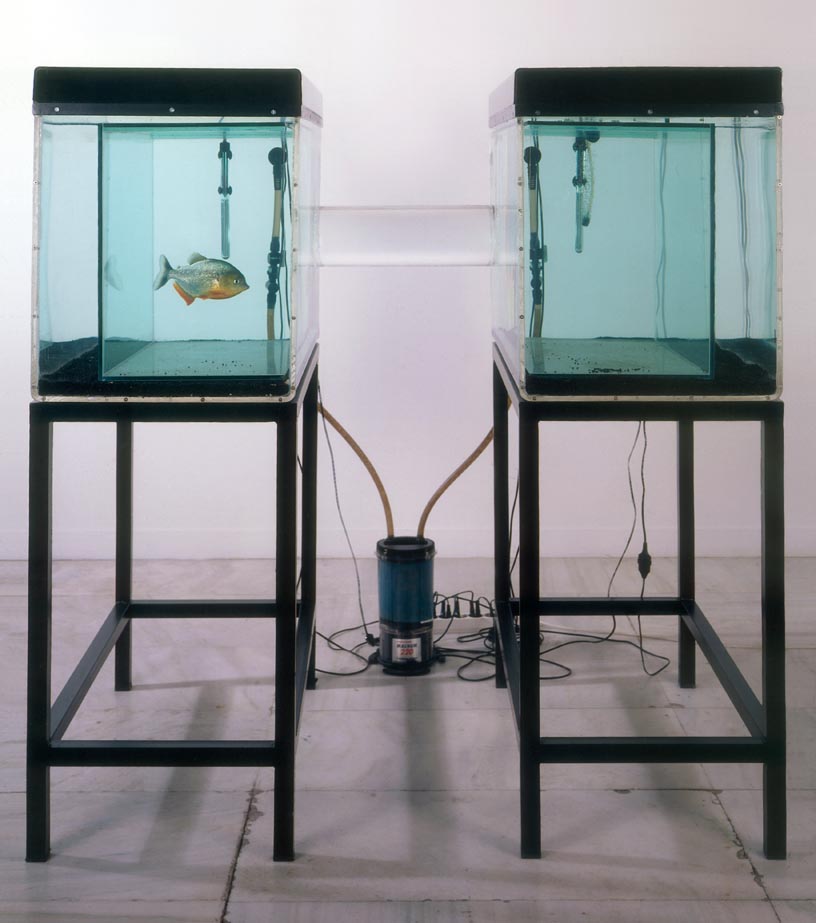
Before piranhas were depicted in celluloid as “killers”, myths about bloodthirsty piranhas were perpetuated by the sale of mounted souvenirs. Dried out after they were soaked in formalin and then varnished, their lips were cut away to bare their sharp teeth.
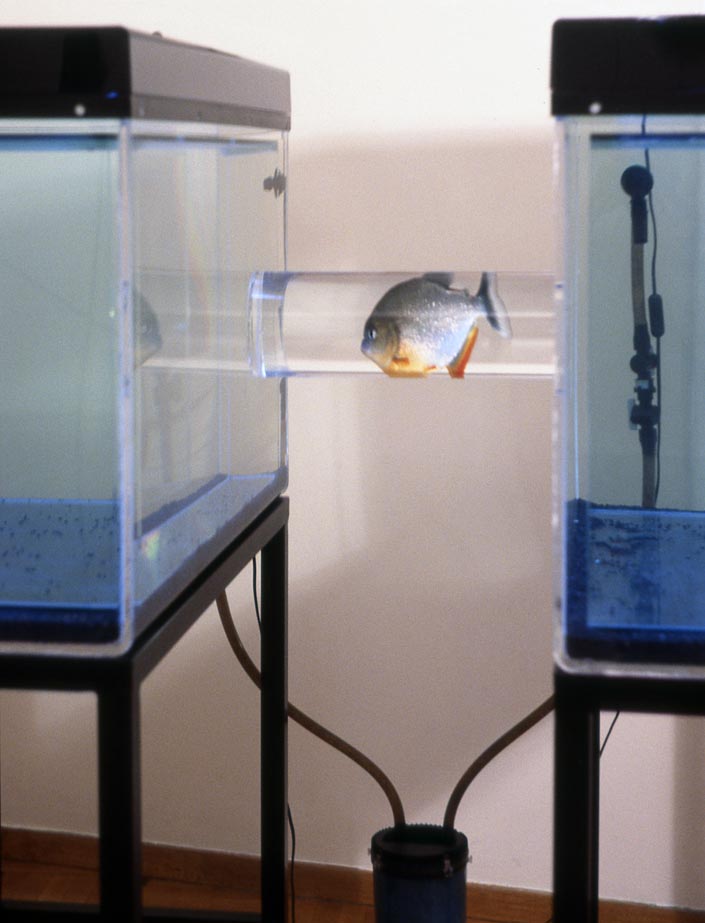
By all accounts a formidable and dangerous creature, the piranha in Trial separation is at a disadvantage. Piranhas are very perceptive and shy. They are sensitive to sudden movements and our size alone intimidates them. Physical contact with the aquarium will make the fish apprehensive and anything entering the space between the two tanks is perceived by the piranha as a violation of its territory.
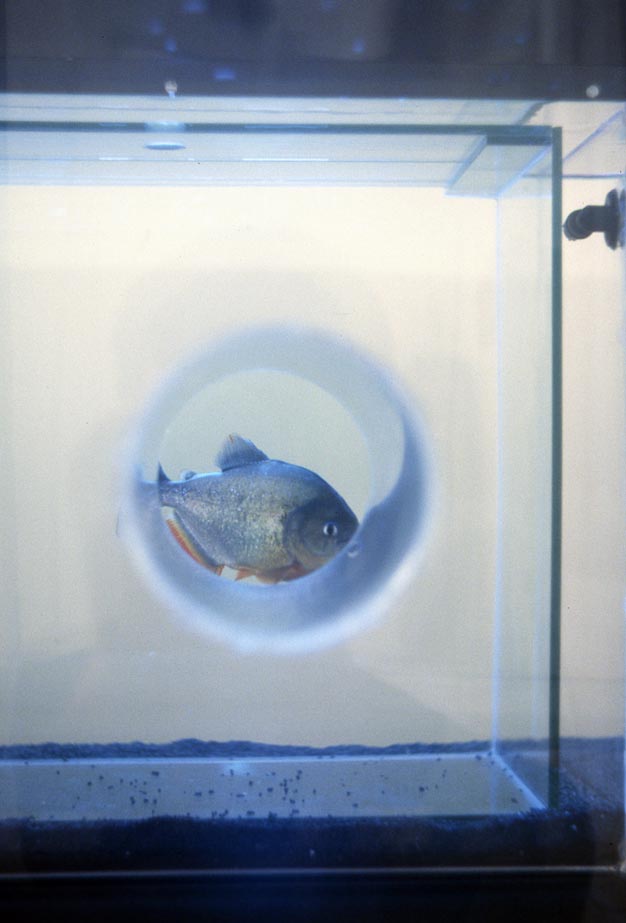
Trial separation is fully equipped to function as an aquarium. The overall volume and space of the aquarium is significant to the well-being of a fish in captivity. The aquarium system in Trial Separation carries 600 litres of water. The biological power filter recycles 200 liters of water per hour. Partial water changes are necessary approximately every 10 – 15 days, including cleaning of the water filter. Thermostat controlled heaters maintain the temperature at a more or less constant level of 26 degrees Celsius – the best average temperature for piranhas. Piranhas are very tolerant to water chemistry, but soft slightly acid water with a hardness of 10 DH and pH of 6.5 is generally recommended. Piranhas are very shy and nervous, they take fright readily. Glaring light can intensify stress, therefore the aquarium is covered and fitted with warm white fluorescent tubes for soft light conditions.
Piranhas are robust with stocky bodies compressed laterally. Many species of piranha have a metallic iridescence on their scales. Its fully developed bony skeleton enables the piranha to make quick strong snake-like swimming movements. External sex differences are not discernible. The eyes of the piranha are perfectly adapted for close-up vision, they survey a wide field of view, but the broad visual fields of the eyes intersect in a very narrow field of stereoscopic vision. Piranhas have an extraordinarily acute sense of smell and a sharp and extremely powerful dentition. The diet of large piranhas consists of large pieces of fresh meat. Because of their nutritional value and vitamin content, heart and liver are particularly suitable, while foodfishes prevent calcium deficiency. Piranhas living with smaller fish will hunt them but will more readily consume pieces of meat or fish when fed regularly. As a rule piranhas are fed sizable portions every other day, but their eating habits vary. Sometimes adult piranhas go through fasting periods so their feeding rhythm should be monitored every day and food remnants should be removed.
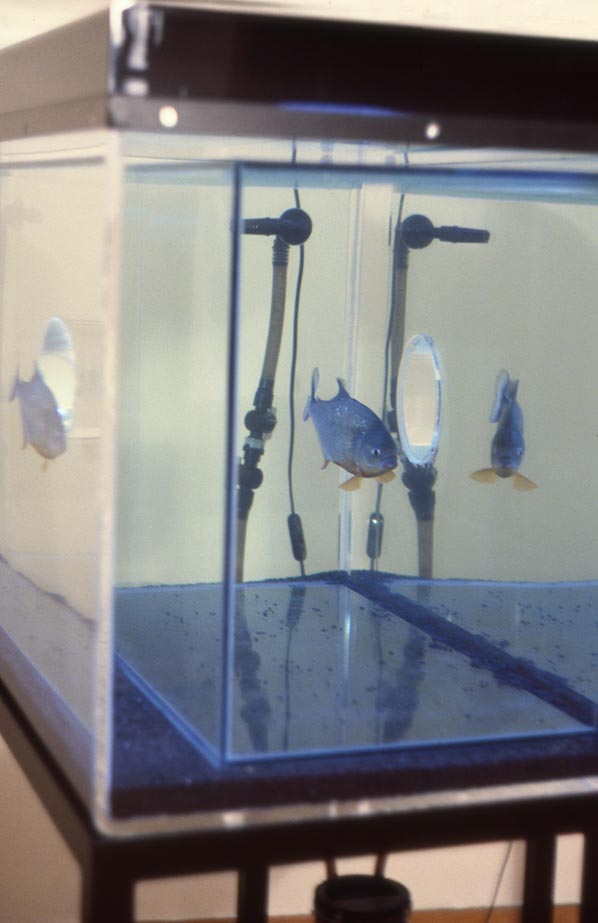
Being cannibalistic, piranhas sometimes attack members of their own species, but healthy fish appear to observe a truce among themselves, which effectively inhibits the biting drive. Nevertheless, it is not uncommon that of a whole shoal of fry in an aquarium tank, one or two strong specimens grow into adults. Unlike predacious fishes which swallow their prey whole, piranhas can bite off a morsel that fits into their mouths. In this respect, the feeding behaviour of the piranhas is very similar to that of sharks, and among freshwater fishes it is unique. Often piranhas get so intoxicated and excited during feeding that they take bites out of each others’ fins or bodies as well or, in some cases, launch a full-scale attack on one another. Piranhas practice genuine brood care. During the spawning period their aggressiveness increases considerably as they fiercely defend their spawning territory. Breeding of piranhas in captivity is rare.
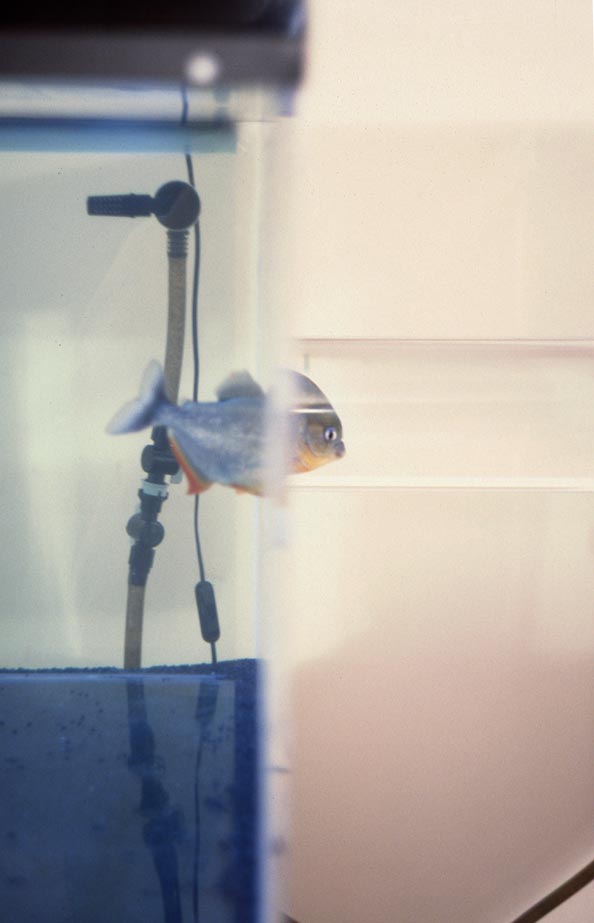
The South American river systems constitute the natural range of the piranha. The majority of piranhas live in the whitewater rivers that carry loamy water with a great deal of fine material in suspension. Most of the water is dark and temperatures are constant between 26 and 30 degrees Celsius. Piranhas also occur in zones where whitewater and blackwater rivers mix. Blackwater rivers rise in tropical forest swamps and flow through extensive tree-clad plains. Tree roots standing in the water and rotting vegetable matter extract oxygen, scarce as it is, from the blackwater. The variations in the water level of the rivers in the warm, humid tropics are often considerable despite constant rainfall. During the drought, the habitats evaporate and shrink. Fish that get trapped in these stagnant waters are crowded together. A school of piranhas cut off in this way and faced with an increasing shortage of food becomes more aggressive. By devouring sick, weak and dead animals, piranhas undertake an important ecological function. Without them, disastrous epidemics might result, particularly after destructive floods. The majority of flood victims are wild animals, their decaying carcasses load the already highly active water, spreading contagious diseases. Piranhas combine different modes of behaviour typical of terrestrial carrion-eaters. Like hyenas, piranhas sometimes hunt on their own or in small groups. They feed not only on carrion, but attack everything that is injured, sick or weak. Like vultures, they often occur in large numbers and act as a health squad by eating everything except the skeleton. Piranhas are largely resistant to fungal diseases. Sick or weak piranhas are vulnerable to stronger members of their species, but smaller injuries caused by biting during a feeding frenzy regenerate quickly.
Bibliography
Basilis Brondisis (1995). Personal correspondence. Biologist and Ichthyologist, Patras, Greece.
Manolito Pinkguni (1996). Piranhas. New Jersey: TFH Publications.
Aggelos Pitsikalis (1995). Personal communication. Aquarium specialist, Athens, Greece.
Wolfgang Schulte (1988). Piranhas in the Aquarium. New Jersey: TFH Publications.
Sophia Kosmaoglou at the Icebox. Lia Yoka, October 1995
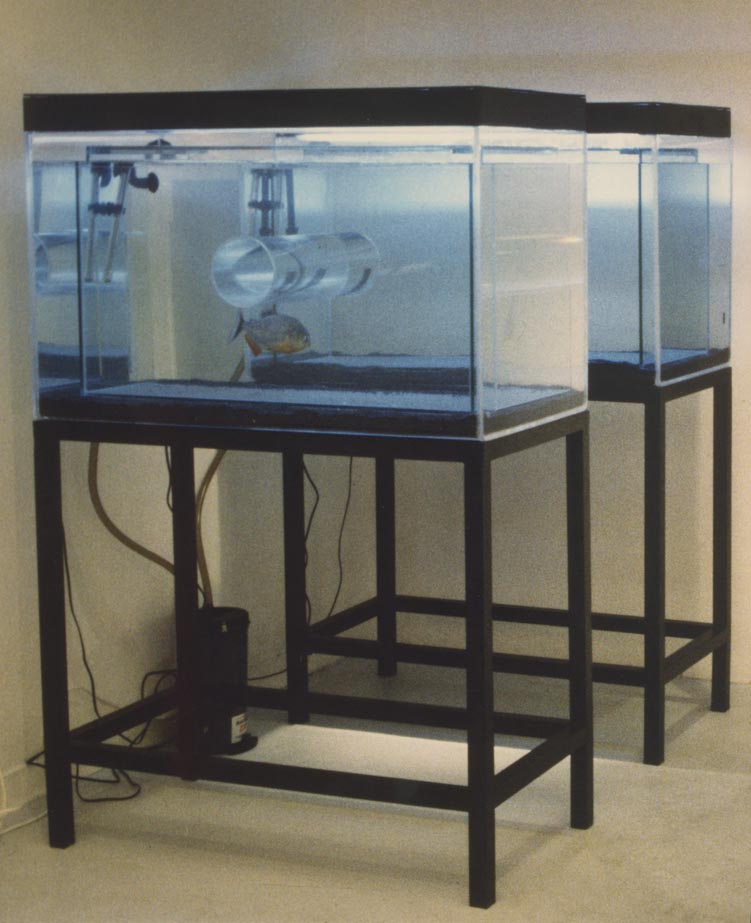
…when I made a mark, somewhere beneath the near ribs, the nature of the page changed again. The area of opaque light suddenly ceased to be limitless. The whole page was changed by what I had drawn just as the water in a glass tank is changed immediately after you put a fish in it. It is then only the fish that you look at. The water merely becomes the condition of life and the area in which it can swim. (J. Berger, Permanent Red, London (1960) 1979, p.26)
Sophia Kosmaoglou’s Trial Separation has a very elaborate, multilevel syntax: As all her more recent work, it poses the philosophical problem of the subject, the acting individual caught up in a web of abstract cosmic relationships, as well as the problem of aesthetic communication within and beyond the boundaries of the market. The fish, (a surrealist dream unit, a symbol of minimal life, and furthermore, a geometrical shape that breathes) becomes at once an indicator and an agent of the options opened up through the movement in communicating vessels. It suffers the limitation and at the same time decides what to make of it. The container is hermetically specific and closed, movement within it is measured in space, as in an hourglass. Is the aquarium, this home to the domesticated fish, separated in the two halves of a lost unity, or is it doubled through its trial section? The tube, the umbilical cord that connects the two identical pieces, is the locus of transition of the fish from one aquarium to the other, only the transformation that happens within it (within this Superman’s phonebooth), leads to an exactly parallel, simulated state. The multiple significations of analogy, comparison and balance have preoccupied Kosmaoglou in her former work, still in Trial Separation the poststructuralist sensitivity of the installation has achieved an exceptionally rich production of meaning. The aquarium itself is the archetypal display case: transparent, cubic, absorbing all tension and withholding information about itself by acting as a neutral frame for a distant, but appropriated world. It retains the water, while impeding its flow, and holds its shiny inhabitant in captivity, while keeping it alive for exhibition. The large see-through tanks allow the viewer to catch a fleeting reflection of their own image in the glass, to marvel at the light as it breaks with every swerve of the swimming fish, then to realise that the animal is actually calculating and marking points in perpetual co-ordinate systems.
The trial separation worked. Sophia Kosmaoglou, 1998
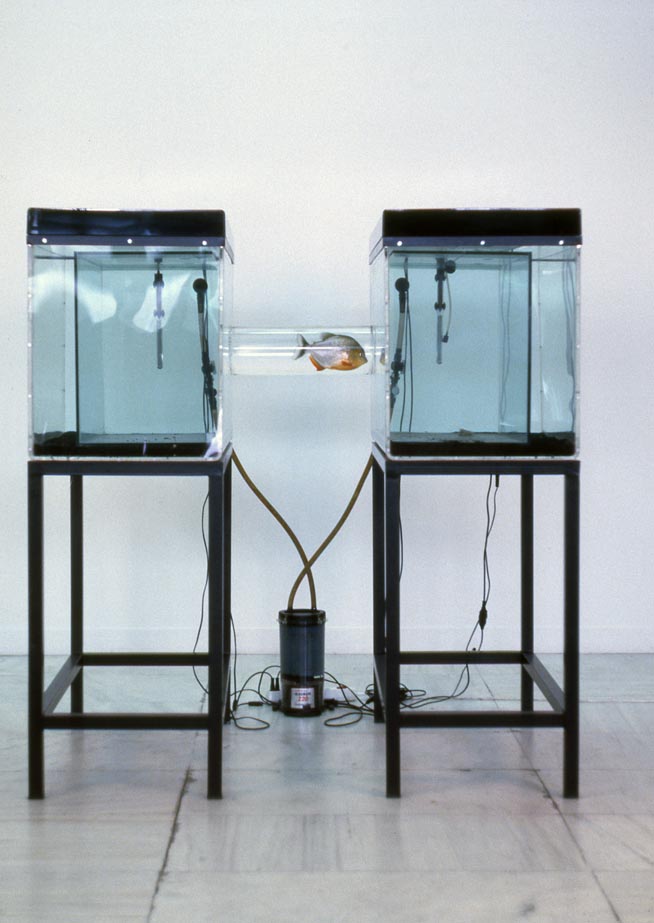
A trial separation is a closed system engaged in a change. This transient state contains its future and its past. It is the present in an emergency. It contains transcendence, death and birth, but the umbilical cord has not been severed. The aquarium is a display case, it is an artificially isolated environment which must be preserved, through the expenditure of energy, to maintain a stable state. Trial Separation is a logical action, a dissection, immobilised and preserved. (Sophia Kosmaoglou, More DNA Stories press release, 1995. Icebox, Athens)
After almost three years, the Trial Separation experiment has ended. Trial Separation has served as a fully functioning aquarium to four different fish, in as many countries. Two of them were piranhas, the other two were pacus, often referred to deceptively as “vegetarian piranhas” in some pet shops. Piranhas are scarce on the market because unlike most breeds of tropical fish, they do not breed in captivity and are illegally imported from the Amazon. They are shy, nervous, aggressive and prone to cannibalism.
Observation 1 The experiment set out to explore the process of separation. A relationship was regarded as a single entity, an atom, from the Greek ἄτομον which means that which cannot be divided.
Observation 2 Trial Separation is an episode in a sequence of events, a transition between a past state and a future state. Structurally it is frozen in a single paradoxical state, it is both a divided totality and a connected duality.
Observation 3 When it was exhibited in Germany, Trial Separation acquired a social signification; it became a metaphor for Berlin society after the initial exhilaration in the years following the city’s reunification. The city has been re-divided since then with an imaginary wall, created by the collective choice of its citizens. The period of estrangement while the city was divided by a barrier (1961-1989) effectively formed two distinct cultures.
Deduction 1 To conclude that a separation was successful, one would have to accept that there was a unity to begin with. The link which precariously joins the two parts is also a gap.
Observation 4 The need for intimacy and identification coincides with the need to withhold and preserve ones’ identity. Self-definition and self-transcendence are desires that cannot be added up. The individual is fragmented and plural, yearning for annihilation while performing vampirism.
Observation 5 With the unravelling of a relationship we cannot be dealing with separation in the literal sense. The volatility of a state of affairs depends on its potential for change. We tend to think in terms of concrete states, outcomes and definitions, yet the flow of events leads us not into situations, but through them.
Deduction 2 Rather than separation, what we have instead is dispersion or transformation. The splitting of the atom in nuclear fission causes the release of energy in an explosion. This sort of transformation does not occur within the aquarium. In the paradoxical frozen state of Trial Separation the piranha remained intact, though often faced with the dilemma of a split environment.
Bibliography
Georges Bataille (1988). The Accursed Share: an essay on general economy. New York, Zone.
Georges Bataille (1988). Guilty. New York, Venice: Lapis Press.
Arthur Koestler (1967). The Ghost in the Machine. London: Hutchinson.
EXHIBITIONS More DNA Stories, Icebox, Athens, 1995 School of Fine Art Graduate Exhibition 1995, National Gallery, Athens, 1996 (Cat) Greek Realities, Stiftung Neue Kultur, Galerie im Marstall, Berlin, 1996 (Cat) Greek Realities, Kunsthallen Brandts Klaedefabrik, Odense, 1997 5th International Biennial, Darphane-i Amire, Istanbul, 1997 (Cat)
COURTESY the artist EDITION 1 + artist’s copy
Sophia Kosmaoglou TRIAL-SEPARATION (1995)
Glass, acrylic, metal, gravel, power filter, heaters, fluorescent lamps, piranha, 167 x 102 x 147 cm.
